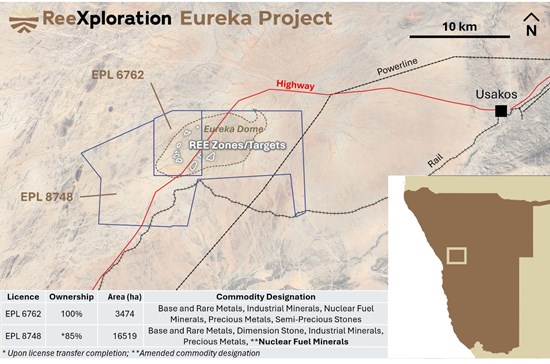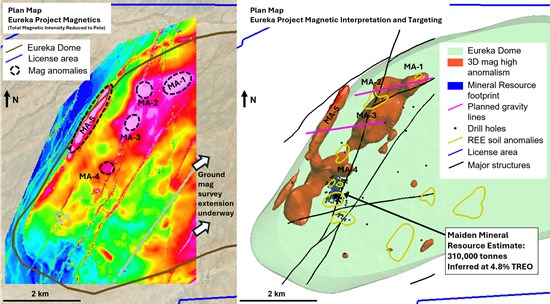ReeXploration Identifies Extensive Magnetic Features Suggesting Broader Rare Earth Potential at Eureka Project
ReeXploration finds large, shallow magnetic features at Eureka, Namibia, indicating potential for expanded REE mineralization and deeper intrusive bodies linked to known resources.

Michael Chen
Senior Mining Analyst
Geophysical data points to significant unexplored rare earth potential at shallow depth
Halifax, Nova Scotia--(Newsfile Corp. - November 4, 2025) - ReeXploration Inc. (TSXV: REE) (FSE: K2I) ("ReeXploration" or the "Company") is pleased to announce that detailed investigation of geophysical data has revealed a series of previously untested, large magnetic features at its flagship Eureka Project ("Eureka" or the "Project"), located in the Erongo Region, central Namibia, indicating potential for resource expansion.
Analysis of the new magnetic data suggests the rare earth element ("REE") mineralizing system at the Project may be larger than currently defined. The magnetic features may represent deeper intrusive bodies potentially linked to the shallow REE mineralization discovered to date. The Project hosts a maiden NI 43-101 Inferred Mineral Resource Estimate1 along with multiple near-surface exploration targets. The REE mineralization is hosted in monazite, the primary REE mineral for neodymium ("Nd") and praseodymium ("Pr"), both critical for low carbon technologies.
Highlights of the results include:
New discovery potential at depth: Multiple untested magnetic features identified over a 5 km strike length across the northwestern flank of the Eureka Dome. 3D magnetic data modelling indicates the interpreted bodies begin between 50 to 100 m below surface.
Magnetic bodies may represent REE-bearing intrusives: The magnetic bodies could be intrusive carbonatites – REE-hosting bodies linked to the known near-surface mineralization. At least one carbonatite phase on the project is known to be highly magnetic, validating the magnetic data as a potential indicator of REE mineralization.
Magnetic bodies align with potential feeder structures: The magnetic bodies converge along key structural lineaments – potential pathways for mineralizing fluids typical of large carbonatite-type REE systems.
Multiple REE targets support strong discovery potential: These newly identified magnetic bodies add to the growing inventory of REE targets on the Project, including the large REE soil anomaly identified near the southern flank of the Eureka Dome, as reported in the Company's News Release dated October 1, 2025.
Next steps underway: A gravity survey is planned to evaluate the size and density of the magnetic bodies ahead of drilling to test for further REE mineralization and resource expansion potential.
Tolene Kruger, Senior Geologist for ReeXploration, stated, "The integration of surface geology with magnetic data modelling reveals structural complexity beneath Eureka that points to a potentially larger mineralizing system. These interpreted magnetic bodies could represent feeder zones to the rare earth mineralization discovered at surface. Further characterizing their nature through upcoming ground gravity surveys will be an important step in refining targets ahead of drill testing."
Chris Drysdale, Interim CEO, commented, "Eureka continues to stand out as a strategically positioned rare earth project – with favourable metallurgy, a strong jurisdiction, and growing potential scale. The newly defined magnetic targets strengthen our view that Eureka hosts a much larger rare earth system – a goal well aligned with the global drive to secure sustainable NdPr supply."
Metallurgy and Market Context – Strategic Importance of Nd and Pr
At Eureka, early metallurgical testing has confirmed that known REE mineralization is hosted in monazite-bearing carbonatite, a favourable mineralogy recognized for low impurities, low radioactivity, and compatibility with Western processing standards. Testwork has already produced a concentrate with ~60% TREO after gravity and magnetic separation, confirming processability and providing key early-stage technical derisking. Neodymium (Nd) and Praseodymium (Pr) are the primary drivers of value, essential for permanent magnets used in EVs, renewable energy systems, and defense technologies. Global demand for NdPr oxides continues to accelerate as governments prioritize secure and sustainable critical-mineral supply chains. Western nations have introduced new funding, tax incentives, and offtake frameworks aimed at reducing dependence on single-country sources of rare earths. Namibia – ranked among Africa's most attractive mining jurisdictions – offers a stable, infrastructure-rich, and regulation-transparent environment for rare-earth development. Projects like Eureka are positioned to play a role in diversifying global supply of responsibly produced magnet-metal feed.

Figure 1: Position of the Eureka Dome and REE targets within the Company's license holding.
To view an enhanced version of this graphic, please visit:
https://images.newsfilecorp.com/files/6102/273032_d136ea6174115969_001full.jpg
Advancing Toward the Next Discovery Phase
Interpretation of the high-resolution ground magnetic dataset from 2022 suggests potential for a more extensive REE system within the 13 x 6 km Eureka Dome. The magnetic bodies (MA-1 to MA-5; 50 nT – >150 nT above background) defined by 3D magnetic modelling lie coincident with, or adjacent to, major interpreted structures that could have acted as conduits for carbonatite intrusions (Figure 2 and Figure 3).
In addition to the identification of the magnetic bodies, the radiometric data highlights low-potassium zones coincident with mapped calcrete cover, a common surficial pedogenic sediment that covers known carbonatite occurrences within the Eureka Dome. Calcrete tends to fill slumped depressions forming a cap above calcium carbonate (CaCO3) source rocks underneath – in this case potentially representing carbonate-altered corridors or concealed carbonatite intrusives.
Together, these datasets point to significant unexplored potential at relatively shallow depth, related to the existing at-surface dyke-hosted REE mineralization hosting a maiden NI 43-101 Inferred Mineral Resource Estimate1.

Figure 2: Left: Ground magnetics (TMI RTP) showing the high magnetic features (pink, dashed black outline). Right: VOXI modelling done on the ground magnetic data reveals the magnetic bodies (MA-1 to MA-5) converge below surface into potential feeder zones, and lie coincident with, or adjacent to, major interpreted structures that could have acted as conduits for carbonatite intrusions.
To view an enhanced version of this graphic, please visit:
https://images.newsfilecorp.com/files/6102/273032_d136ea6174115969_002full.jpg

Figure 3: Isometric view (looking NW) of the VOXI model showing the magnetic bodies have at least 5 km strike extent.
To view an enhanced version of this graphic, please visit:
https://images.newsfilecorp.com/files/6102/273032_d136ea6174115969_003full.jpg
Planned Gravity Survey
ReeXploration is planning to conduct a gravity survey across the magnetic anomalies (MA-1 to MA-5) (Figure 2 and Figure 3). Survey specifications are to be confirmed. The survey will generate a density model to help determine if the magnetic bodies have any significant density association. The magnetics together with the gravity data will provide essential geometric information and physical properties of the magnetic features and refine targets for drilling. The Company is engaging with various qualified service providers to conduct the survey work.
References & Technical Disclosure
- The current maiden Inferred Mineral Resource Estimate ("MRE") for the Eureka Project includes 310,000 tonnes at 4.8% TREO (including 0.7% Nd+Pr oxides) from the initial 19 drill holes (613 metres) completed across Zones 1-3. The MRE was prepared by SRK Consulting (UK) with an effective date of August 2, 2021. An Independent Technical Report titled "Independent Technical Report: Eureka, Rare Earth Project, Namibia" was filed on SEDARplus on September 15, 2021, supporting the disclosure of the MRE, and is available on www.rareearthexploration.com.
The 2022 ground magnetic survey was carried out by Remote Exploration Services (Pty) Ltd. ("RES"). A total of 1,151.5-line km of high-resolution ground magnetic survey data was collected along a line spacing of 25 m at an azimuth of 340 degrees. RES utilized a GEMSys GSM19 Overhauser magnetometer to collect base data and another GEMSys GSM19 Overhauser magnetometer to collect walk data. The walk magnetometer was set to a sample frequency of 1 Hz while continuously walking along survey lines. QA/QC and processing procedures were applied, generating final magnetic products for interpretation. A three-dimensional magnetic inversion was completed using Seequent's VOXI™ platform in Geosoft, employing a 50 x 50 x 50 metre voxel configuration. The modelling provides a 3D representation of subsurface magnetic sources to assist in geological interpretation.
Qualified Person
Tolene Kruger, BSc. (Hons), M.Sc., is a consulting geologist and has reviewed and approved the scientific and technical information in this news release. Mrs. Kruger is registered as Professional Natural Scientist (Pr.Sci.Nat.) with the South African Council for Natural Science Professions (SACNASP, Reg. No.: 148182), and a Qualified Person for the purposes of National Instrument 43-101 - Standards of Disclosure for Mineral Projects.
About ReeXploration Inc.
ReeXploration (TSXV: REE) (FSE: K2I) is a Canadian exploration company positioned to help meet surging global demand for secure, responsible supplies of critical minerals essential to the clean energy transition, advanced technologies and national defense. The company's flagship Eureka Project in central Namibia hosts rare earth element (REE) mineralization in monazite, rich in NdPr magnet metals, with bench-scale testing confirming production of a clean, Western-standard concentrate. Supported by a Namibia-based technical team and guided by global critical minerals experts, ReeXploration is advancing discovery-led growth for rare earth elements (REEs) and other critical minerals, building a credible, ESG-aligned platform positioned to benefit from the global race to diversify and secure responsible supply chains.
Caution Regarding Forward-Looking Information
This press release may contain forward-looking information. This information is based on current expectations and assumptions (including assumptions relating to general economic and market conditions) that are subject to significant risks and uncertainties that are difficult to predict. Actual results may differ materially from results suggested in any forward-looking information. ReeXploration does not assume any obligation to update forward-looking information in this release, or to update the reasons why actual results could differ from those reflected in the forward-looking information unless and until required by securities laws applicable to ReeXploration. Additional information identifying risks and uncertainties is contained in the filings made by ReeXploration with Canadian securities regulators, which filings are available at www.sedarplus.ca.
Neither the TSX Venture Exchange nor its Regulation Services Provider (as that term is defined in policies of the TSX Venture Exchange) accepts responsibility for the adequacy or accuracy of this release.
Further details are available on the Corporation's website at www.rareearthexploration.com or contact Christopher Drysdale, Interim CEO of ReeXploration Inc., at +1 902-334-1949, [email protected].

To view the source version of this press release, please visit https://www.newsfilecorp.com/release/273032
Tags

Michael Chen
Michael has over 15 years of experience covering junior mining companies, with a focus on precious metals exploration and development.
View All Articles →